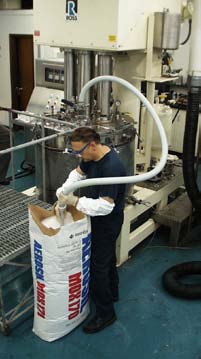Tech Report
Improve safety in your mixing room.

Technology Brief
This bulletin discusses some practical and technical solutions for improving safety in the mixing area.
Safety in the mixing area
In the processing world, safety management cannot be overemphasized. In particular, the mixing room, where raw materials are combined to produce the final formulation, is a source of many potential health and operational hazards. Any toxic chemicals, dusty powders, flammable solvents, or slippery fluids that are present can compromise operator safety if not handled properly. Workers must be trained on how to safely operate any piece of mixing equipment.
Aside from typical engineered solutions and safety systems, there are some basic and practical ways for improving safety in the mixing area. The discussion below lists a few considerations that process engineers can apply to existing operations and during equipment procurement.
Some safety tips

- Keep it clean. Many accidents, equipment failures and explosions are prevented through simple good housekeeping and regular maintenance. This should include periodic inspection of all moving parts, electrical wiring and safety devices in the mixer. Tell your supplier if you intend to clean the mixer by hosing it down with water. This may require special covers for certain parts of the mixer and control panel, in addition to wash down duty motor(s).
- One of the first things you must discuss with your mixer manufacturer is the hazardous classification of your mixing area. Specifying the exact class, division and group will help ensure that your mixer will have the proper motor, limit switches, controls, etc. If the mixing application itself is explosive, the mixer can be supplied with blow out and fire suppression vents, lock-wired hardware, grounding straps, conductive coatings, special bushings for static dissipation, etc. A remote control system and explosion-proof video camera assembly mounted on the mixer will allow operators to control and view the mixing progress from a safe room.
- Manage dusting. While dust collection systems can be employed in the mixing area to capture airborne particles, preventing their release is a better strategy. One technique is to eliminate the dust-generating steps of transferring powders from their original container and dumping them into the liquid surface of a mix vessel. Consider a closed mixing system equipped for sub-surface powder induction. For example, a Ross high shear rotor/stator mixer with Solids/Liquid Injection Manifold (SLIM) Technology enables operators to simply draw powders straight from the bulk container using a wand attachment. This powder handling method generates virtually zero dusting.
- When mixing tough, sticky mixtures, operators are often left to contend with manually scraping product off vessel surfaces and/or using up a fair amount of harsh solvents. A practical solution is to use a discharge system which consists of a platen that is lowered hydraulically into the mix vessel. The platen is fitted with an O-ring which rides against the vessel wall, virtually wiping it clean. Product is forced out through a valve on the bottom of the vessel, or through the top of the platen. Automating the discharge process reduces operator exposure to a hazardous batch, minimizes the release of harmful vapors into the plant atmosphere and decreases the amount of cleaning solvents required after every mixing cycle.
Sample Installation

An all-stainless steel Ross VersaMix Multi-Shaft Mixer is being used at a pharmaceutical facility to make high quality Carbopol solutions. An air/oil hydraulic lift allows complete operator access to the agitators and batch product. Safety limit switches and proximity sensors prevent the operation of the drives when the stirrers are in the raised position or when the vessel is removed from the mixing position.